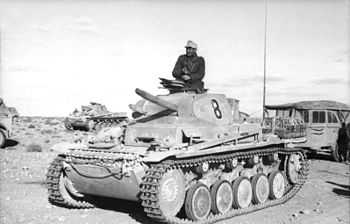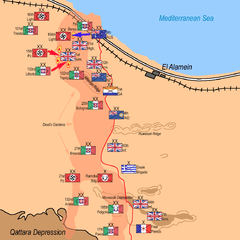15th Panzer Division (Wehrmacht)
| German 15th Panzer Division | |
|---|---|
|
Unit insignia | |
| Active | 1941–43 |
| Country |
|
| Allegiance |
|
| Branch | Heer |
| Type | Panzer |
| Role | Armoured warfare |
| Size | Division |
| Part of | Deutsches Afrikakorps (DAK) |
| Engagements | |
| Commanders | |
| Notable commanders |
General der Panzertruppe Hans-Karl Freiherr von Esebeck Oberst Eduard Crasemann Generalleutnant Gustav von Vaerst |
| ||||||||||
The 15th Panzer Division was an armoured formation of the German Army in World War II.
North Africa
The division was transported to Libya in April 1941, joining General Erwin Rommel's Deutsches Afrikakorps (DAK) with the 21st Panzer Division and the 90th Light Infantry Division.
By June 15 it was deployed in reserve to the south of Bardia and took part in a successful defensive operation during Operation Battleaxe at Halfaya Pass.
On November 18 British forces began Operation Crusader with the objective of relieving the besieged forces at Tobruk. The 15th Panzer Division was situated to the east of Tobruk, and by November 20 they joined the 21st Panzer Division in fighting the armoured forces of the British XXX Corps. With XXX Corps situated on the approaches to Tobruk, Rommel sent his panzer divisions on a rapid advance to the east, threatening the British rear. However the British continued to advance on Tobruk and by November 27, they had linked up with the fortress. The Axis forces were forced to withdraw.
Rommel halted at El Agheila on December 31, 1941 for refitting of his depleted forces. By January 21 he was ready to advance again, the DAK and Italian forces began another march to the east. The British Eighth Army had drawn up in mine-fortified positions around the coastal town of Gazala, to the west of Tobruk. The 15th Panzer Division was deployed with other Axis armour on their southern flank, and infantrymen holding the northern part of the line. The Axis began their attack on May 26, with the DAK sweeping around the southern end of the British line. They were met by British armoured forces and, after heavy fighting, sustained the loss of a number of tanks. Without a supply line, the Germans had to withdraw into a "Cauldron" position of the front until supplies could be moved through the minefields.



They began their breakout on June 11, advancing to the east and threatening to encircle the British. The Eighth Army was forced to withdraw, leaving Tobruk encircled once more. This time, however, the Tobruk fortifications were weaker.
An attack on June 20, which included 15th Panzer Division, captured the town and the garrison. The Axis forces began a rapid advance to the east. Much of XXX Corps' armour had been destroyed at Gazala, so a stand at Mersa Matruh on June 26 was quickly broken. In this battle the 15th Panzer Division was held up by the British 1st Armoured Division, but the remainder of the DAK broke through to the north.
At the beginning of July the Eighth Army had reached their final defensive position before Alexandria at the rail junction of El Alamein. The DAK was understrength from its recent battles, but Rommel attempted an attack along Ruweisat with the 15th Panzer Division and the remainder of the DAK. Only minor progress was made, British counterattacks and mounting German losses caused Rommel to call off the attack on July 22.
Another attack was attempted on August 30, with Rommel's armoured forces attacking the southern flank. The 15th Panzer Division reached as far as the Alam Halfa ridge on September 1, but failed to break through the British defences. At this point Rommel went on the defensive and began to build a comprehensive position with deep minefields. The 15th Panzer Division formed the reserve in the northern part of the front, with the 21st Panzer Division to the south.
With the able General Bernard Montgomery taking charge of the Allied forces, the Eighth Army underwent a steady buildup that the Axis forces could not match. By October 23, Montgomery's forces were ready and they began an attack on the northern front. Counterattacks by 15th Panzer failed to halt the advance; by November 4 British tanks had achieved a breakout.
Now began a period of steady British advance to the west, combined with the Allied landings (Operation Torch) in French North Africa on November 8. The remains of the 15th Panzer Division and the remainder of the Axis forces, were continually forced to withdraw.
XXX Corps reached and out-flanked the line at El Agheila on December 17, then took Tripoli on January 23, 1943. By February 18 XXX Corps reached the defensive line at Mareth in Tunisia and were forced to halt. The 21st Panzer Division was drawn away to the Kasserine Pass operation on February 22, so 15th Panzer held the Mareth Line with the remaining Italian forces.
On March 6, with the 21st Panzer Division having returned, the DAK counterattacked the Eighth Army at Medenine, but were repulsed. On the 20th, the British 50th Infantry Division breached the defensive position, but they were contained by the 15th Panzer Division. However the Axis position was out-flanked in the west, so by March 27 they were forced to withdraw to the north.
The Axis forces in North Africa were forced back to their final defensive position in northern Tunisia. Adolf Hitler chose this time to heavily reinforce his forces in this theatre; forces that would have been far more effective a year earlier. But by now it was too late, the U.S. First and British Eighth Armies fought relentlessly through the Axis defences.
By May 12, 1943, all German and Italian forces in Tunisia surrendered, including the 15th Panzer Division.
Commanding officers
- Generalleutnant Friedrich Kühn (November 1940 – 21 March 1941)
- Generalleutnant Heinrich von Prittwitz und Gaffron (22 March 1940 – 10 April 1941)
- Oberst Maximilian von Herff ( 10 April 1941 – 13 April 1941)
- General der Panzertruppe Hans-Karl Freiherr von Esebeck (13 April 1941 – 13 May 1941 )
- Oberst Maximilian von Herff ( 13 April 1941 – 16 June 1941)
- Generalmajor Walter Neumann-Silkow (16 June 1941 – 6 December 1941)
- Oberst Erwin Menny (6 December 1941 – 8 December 1941 )
- Generalmajor Gustav von Vaerst ( 9 December 1941 – 28 May 1942)
- Oberst Eduard Crasemann(28 May 1942 – 15 July 1942)
- Generalmajor Heinz von Randow(15 July 1942 – 25 August 1942)
- Generalleutnant Gustav von Vaerst(25 August 1942 – 11 November 1942 )
- Generalleutnant Willibald Borowitz(11 November 1942 – 13 May 1943 )
Organization / Order of Battle
March 1941
- 8 Panzer Regiment (I & II Battalions)
- 15th Infantry Brigade
- 104 Motorized Rifle Regiment (I & II Battalions)
- 115 Motorized Rifle Regiment (I & II Battalions)
- 15 Motorcycle Battalion
- 33 Reconnaissance Battalion
- 33 Motorized Artillery Regiment (I, II & III Battalions)
- 33 Combat Engineer Battalion
- 33 Antitank Battalion
- 33 Divisional services
See also
- Deutsches Afrikakorps, Western Desert Campaign, North African Campaign
- Panzergrenadier, Panzer, Panzer Division
- Division (military), Military unit
References
- ↑ George F. Nafziger, The German Order of Battle: Panzers and Artillery in World War II, p 97-112
| ||||||||||||||||||||||||||||
| |||||||||||||||||||||||||||||||||||||||||||||
